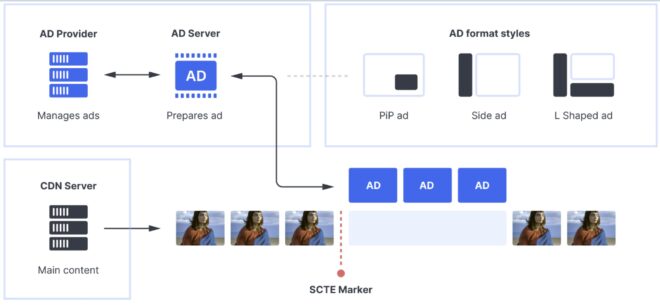We all know the trade-offs of Client-Side Ad Insertion (CSAI) and Server-Side Ad Insertion (SSAI). CSAI offers real-time personalization but is vulnerable to ad blockers and playback hiccups, while SSAI ensures smooth playback and circumvents blockers but lacks real-time targeting and can be expensive.

Now, a new technology has entered the scene: Server-Guided Ad Insertion (SGAI). But what exactly is it, and does it solve the challenges of both CSAI and SSAI?
As I researched these questions, I noticed that Bitmovin had an excellent blog on SGAI, as well as CSAI and SSAI, and obvoiiusly was innovating in this space. So I reached out to a contact there, who introduced me to Jacob Arends, senior product manager of playback, and David Steinacher, a senior engineer on the playback team. You can access the video on YouTube here or watch it as embedded below.
Contents
What is server-guided ad insertion (SGAI)?
Jacob: “It’s kind of a combination of Client-Side and Server-Side ad insertion. So you still have the main content from the CDN. But the server has inserted SCTE markers, so the server still decides when the ad will happen. But through specs like HLS interstitials, you’re giving the client the opportunity to interact with the server and retrieve the ad content.”
So unlike SSAI, where ads are stitched into the stream, SGAI allows for late-stage ad decision-making on the client side, making real-time personalization possible while retaining timing control by the server.
Why not stay with CSAI or SSAI?
CSAI’s strengths and weaknesses
CSAI gives publishers maximum flexibility in serving ads but comes with major trade-offs.
Jacob: “Because the client is making all the decisions and making requests to the ad server, the main drawback of client-side ad insertion is ad blockers, which can intercept and block the ad. That means no ad is served to the customer, and publishers are losing on ad revenue.”
Another major issue? Playback performance, especially on lower-powered devices like smart TVs.
David: “Especially on TVs and low-end devices, the switch between the main content and ad content may be noticeable. And this disruption is definitely one big disadvantage of client-side advertising.”

SSAI’s benefits and drawbacks
On the flip side, SSAI stitches ads into the stream at the server, ensuring smooth playback and bypassing ad blockers. But it sacrifices real-time personalization and comes with scaling challenges.
Jacob: “Because you stitch the content on the server, if you have one ad in each ad opportunity per stream, you lose personalization to the user. You could enable more personalization by enabling more encodes, but this increases the scale of your backend. And that can be quite expensive to have one stream per user and deliver ultimate personalization.”
Additionally, SSAI doesn’t support interactive ad formats like overlays and companion ads.
David: “Server-side ads are usually just video. So, there are no interactive formats or companion ads, for example. On client-side ad insertion in respect to the VAST standard, there are a lot of interactive formats as well.”
Does server-guided ad insertion solve these problems?
Ad blocking risks
One major concern is that SGAI reintroduces the risk of ad blocking.
David: “We will have to see, but the big advantage is that the content comes in a different format. When we switch to HLS interstitial, which is the standard out there at the moment, they were preserved as playlists. So existing ad blockers don’t know those formats yet.”
However, he notes “Of course, if ads are served through a well-known ad domain, then they might be already blocked.”
Playback performance on smart TVs
SGAI still faces challenges with playback performance on lower-powered devices, similar to CSAI.
David: “We will have to see about performance. It could be that the benefit SGAI delivers over CSAI will be small or non-existent. There are thoughts in the industry on how to improve single-decoder behavior on smart TVs, but we will have to see how that ends up in production.”
SGAI unlocks new ad formats
SGAI also enables new ad experiences like picture-in-picture, side-by-side ads, and concurrent content overlays.
Jacob: “SGAI lets you maintain a consistent viewer experience. You’re not taking people away from the content, but bringing the ad to them. This means that discontinuities from switching between the ad content and the main content doesn’t become an issue if you’re presenting an ad as an overlay.”
These new formats could also be used beyond advertising, like inserting sports highlights or promotions for other content within a streaming service.
How ready is SGAI to real-world adoption?
Currently, SGAI is in its early stages, with broader adoption expected in 2025 and beyond.
Jacob: “We have samples and plan to take a few customers live with SGAI in the first half of 2025. But, the ecosystem is still early. There’s only very few adopters at the moment who are live in production.”
Another hurdle? Standardization.
Jacob: “Even things like standardizing how to use interstitials for server-guided ad insertion isn’t quite there. It’s something which the SVTA group is trying to formalize and standardize.”
However, interest is growing, especially in sports and live streaming.
Jacob: “Particularly in sports, you see a really big push towards personalization and the additional experiences you can give to your customers.”
Final thoughts: Is SGAI the future?
SGAI offers a compelling balance between CSAI and SSAI, bringing back real-time personalization, unlocking new ad formats, and keeping servers in control. However, the risks remain—ad blockers could still find ways to interfere, and playback smoothness on smart TVs needs more testing.
As Jacob summed up:
Jacob: “We get many more ad types, additional creativity, and retain server control. And we may be able to overcome the potential risks, as David said, of client-side ad blocking and potential for discontinuity between the streams.”
The bottom line: SGAI isn’t ready for mass adoption yet, but with increasing demand for personalized, engaging ad formats, expect it to play a bigger role in streaming monetization over the next few years.
 Streaming Learning Center Where Streaming Professionals Learn to Excel
Streaming Learning Center Where Streaming Professionals Learn to Excel









